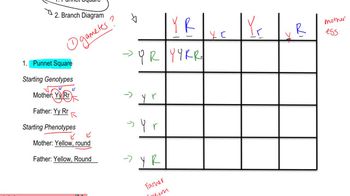Table of contents
- 1. Introduction to Genetics51m
- 2. Mendel's Laws of Inheritance3h 37m
- 3. Extensions to Mendelian Inheritance2h 41m
- 4. Genetic Mapping and Linkage2h 28m
- 5. Genetics of Bacteria and Viruses1h 21m
- 6. Chromosomal Variation1h 48m
- 7. DNA and Chromosome Structure56m
- 8. DNA Replication1h 10m
- 9. Mitosis and Meiosis1h 34m
- 10. Transcription1h 0m
- 11. Translation58m
- 12. Gene Regulation in Prokaryotes1h 19m
- 13. Gene Regulation in Eukaryotes44m
- 14. Genetic Control of Development44m
- 15. Genomes and Genomics1h 50m
- 16. Transposable Elements47m
- 17. Mutation, Repair, and Recombination1h 6m
- 18. Molecular Genetic Tools19m
- 19. Cancer Genetics29m
- 20. Quantitative Genetics1h 26m
- 21. Population Genetics50m
- 22. Evolutionary Genetics29m
2. Mendel's Laws of Inheritance
Dihybrid Cross
Problem 8a
Textbook Question
Based on the preceding cross, what is the probability that an organism in the F₂ generation will have round seeds and green cotyledons and be true breeding?
 Verified step by step guidance
Verified step by step guidance1
insert step 1> Identify the genotypes of the parent organisms in the initial cross (P generation) and determine the alleles involved for seed shape and cotyledon color.
insert step 2> Determine the F₁ generation genotype by performing a Punnett square cross of the P generation. Note that the F₁ generation is typically heterozygous for both traits if the P generation was homozygous.
insert step 3> Set up a dihybrid cross for the F₁ generation to predict the F₂ generation. Use a 4x4 Punnett square to account for all possible combinations of alleles for the two traits.
insert step 4> Identify the phenotype of interest: round seeds and green cotyledons. Determine which genotype(s) correspond to this phenotype.
insert step 5> Calculate the probability of the organism being true breeding for both traits by identifying the homozygous genotype(s) that result in the desired phenotype.
 Verified video answer for a similar problem:
Verified video answer for a similar problem:This video solution was recommended by our tutors as helpful for the problem above
Video duration:
1mPlay a video:
Was this helpful?
Key Concepts
Here are the essential concepts you must grasp in order to answer the question correctly.
Mendelian Genetics
Mendelian genetics is the study of how traits are inherited through generations, based on the principles established by Gregor Mendel. It involves understanding dominant and recessive alleles, genotype, and phenotype. In this context, the inheritance patterns of traits like seed shape and cotyledon color are analyzed to predict probabilities in offspring.
Recommended video:
Guided course

Descriptive Genetics
True Breeding
True breeding refers to organisms that, when self-fertilized, produce offspring that are identical to themselves for specific traits. This means that the organism is homozygous for the traits in question. In the context of the question, determining if the F₂ generation is true breeding for round seeds and green cotyledons requires understanding the genetic makeup of the parents and the resulting offspring.
Recommended video:
Guided course

Chi Square Analysis
Punnett Square
A Punnett square is a diagram used to predict the genetic makeup of offspring from a cross between two organisms. It helps visualize the combinations of alleles that can result from the mating of parent organisms. By using a Punnett square, one can calculate the probability of specific traits, such as round seeds and green cotyledons, appearing in the F₂ generation.
Recommended video:
Guided course

Chi Square Analysis
Related Videos
Related Practice





